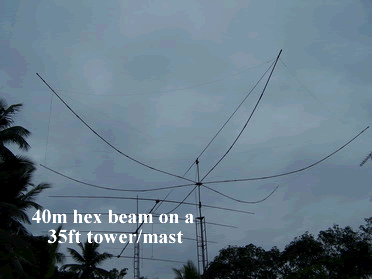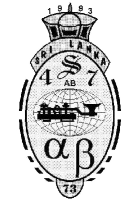Contesting from Sri Lanka
-This article appeared in the July/August 2006 NCJ | Download PDF Here
500+ already viewed!
Article Summary
When I was in Oslo, Norway in 2001, I visited my friend, Halvard Ericsson, LA7XK. He had a summer house with a ham station in the Hvaler Islands in the southern part of the country. Halvard invited me to spend a weekend with his family at the house and said that I could operate his station using my call sign, LA/4S7AB, since the IOTA contest would be taking place at that time.
Article Highlights
- NCJ Inspiration
- Planning a Contest
- Propagation Patters from Sri Lanka

Kamal Edirisinghe
4S7AB / KA5MAL
Author Feb 2007
Having More than 35 years of experience in the Field of Amateur Radio, I have published many articles in prestigious international publications like, QST, CQ-DL, NCJ, Six-News etc.. Here in this web site, these write-ups are intended to give you knowledge about my designs and projects related to the hobby. The articles about foreign HAM activities are intended to share my experience.
- Full Solar Powered Radio Station
- SO2R and Multi-Multi Compatible
- Operate on All Bands/Modes/SATS
- DXCC #61,271
- IOTA AS-003, CQ-22, ITU-41
It was my first contesting experience from Hvaler Islands (EU-061). The operation was casual, using little more than a paper log, but I made 300 QSOs as time permitted. I had prior experience handling pileups from operating in Sri Lanka, so the contest wasn’t difficult.
The following year I found myself in Stockholm, Sweden. Among the many Swedish hams I associated with were two remarkable gentlemen: Teemu, SMØWKA and Henryk, SMØJHF. Teemu is a serious contester; Henryk is not so serious, but he enjoys helping those who are.
I used to go to the big SKØUX multi- multi station with Teemu to watch him in action. (At the same time, I used the idle antennas and rigs to talk back to my home folks in Sri Lanka.) Henryk wasn’t satisfied with just having me watch, how-ever. At his urging I tried my hand at the CQWW SSB competition in 2001. Henryk offered transport, food and a radio for me to use from SKØUX. I was able to complete about 200 QSOs us-ing my own call, SMØ/4S7AB. Europeans normally travel to DX locations for contests, so my presence in Sweden must have seemed a little odd. It caused a few contest contacts to turn into rag chews when I was asked why I wasn’t in Sri Lanka!
That same year Henryk offered to take me to Musko Island (EU-081) for the IOTA contest. I accepted and made about 300 QSOs using his IC-746 transceiver and a long-wire antenna. All this time, Henryk was doing the hard work of cooking, burying radials and setting up the station. What a nice person!
Not long afterward, my work took me back to Sri Lanka. Would I be able to put my newly gained contest experience to use there?

4S7AB inside the shack

Antennas for covering contest bands. In the back – 4 el SteppIR, in the front 40m/30m Hex beam
NCJ Inspiration
During one of my business trips to Richardson, Texas, the Lone Star DX Association president Tom, WW5L, invited me to give a presentation about Amateur Radio activities in Sri Lanka. At the end of the meeting, there were door prizes for the participants. I was astonished to be the winner of a one- year free subscription to NCJ magazine. I wasn’t sure whether the free offer was valid for overseas subscriptions, but I sent my certificate to ARRL HQ with my Sri Lankan address. Imagine my surprise when I received the January/February 2006 NCJ in my mailbox!
I was reading the articles and came across the “Contest Tips, Tricks and Techniques” column by Gary, W9XT. The column grabbed my interest right away. I decided to take part in a contest and put 4S7 on the contesting map. The very next thing I did was check the contest calendar in NCJ. The CQ WW WPX SSB was coming up and I had two days to prepare.
Planning
This contest would be a challenge. Not only was propagation likely to be poor, I had to consider the fact that it was light-ning and thunderstorm season in Sri Lanka. Due to lightning, my village power can trip off at the main transformer at any time. If it trips off on a rainy night, it might not be repaired until the following morning. My solution was to maintain two batteries on solarpanel chargers for alternative power.
I spent some time exploring the bands in the days before the contest. I worked a few Ws over the North Pole on CW around 1AM. European openings on 20 meters after sunset (6PM local time) created some good pileups as well.
I found that 15 meters was also alive with high-power signals on occasion. South Africans and JAs in particular were heard often around noon.
I noted that Australians came in on 20 meters before sunset, but there are only a handful of operators from that continent. For regional contacts, 40 meters was clearly my best option.
After downloading and reading the contest rules, I decided that my main target would be Europe and Russia on 20 meters. The rig was my good old Kenwood TS-930S/AT and the main antenna for the higher bands was the 4- element SteppIR Yagi. I covered the low bands by simply loading my 160-meter vertical. The software I chose was MixW v2.14, which has useful features for con-testing.
I had the NCJ tips and techniques very much in mind while I planned my operation. I wanted to try different S&P techniques, band-change strategies and more. The NCJ articles are written with an American bias, so I had to reorganize and adapt the ideas to the operating conditions here in Sri Lanka.
The Contest Begins
When I started the contest on Saturday morning, March 25, I was surprised to find the 15-meter band open to Europe and Russia. I immediately changed plans and continued operating on 15 until I had worked all the stations I could hear.
I jumped to 20 meters and initially tried low power, but soon realized that I needed a bigger signal to get anywhere with the poor propagation. I turned on the FL-2100Z amplifier, even though it only generates about 250W output with its old pair of 572Bs.
Fifteen meters was hot again Saturday afternoon and I worked Europe, Russia, the Pacific and Japan, totaling about 250 QSOs.
Sunday was much the same as Saturday, except for a late-night opening to the US on 20 meters. That opening net-ted me 48 US contacts.
At the end of the contest I was satisfied to see an overall QSO count of 688 and a claimed score of 687,750 points. I managed to work two new DXCC entities, too.
My next goal is to take part in a CW contest and improve my skills. The superstar for this effort will be my new microcontroller based Bravo Intellikeyer- 1.
The Challenge of Contesting
Contesting is a good way to test your station to its limits while improving your operating skills. Not only do you need to keep your equipment in top shape, you must be highly organized (multi- multi operations in particular need precise coordination and teamwork).
Modern day contesters need above- average equipment if they expect to win. One of the main obstacles for newcomers in my part of the world is the affordability of equipment. Even so, operating as multi-multi teams might allow less privileged hams to pool their re-sources. This is something that should be encouraged.
Contest organizers should consider new categories to stimulate greater interest. For example: solar powered, wind powered, remote operated, etc. Because the world is moving into alternative energies and new technologies, newcomers would enjoy a variety of options.
Perhaps we could also offer reward points to hams who travel to DX locations to operate. This may motivate contesters to put rarer DXCC entities on the air.
– Extracted from NCJ
